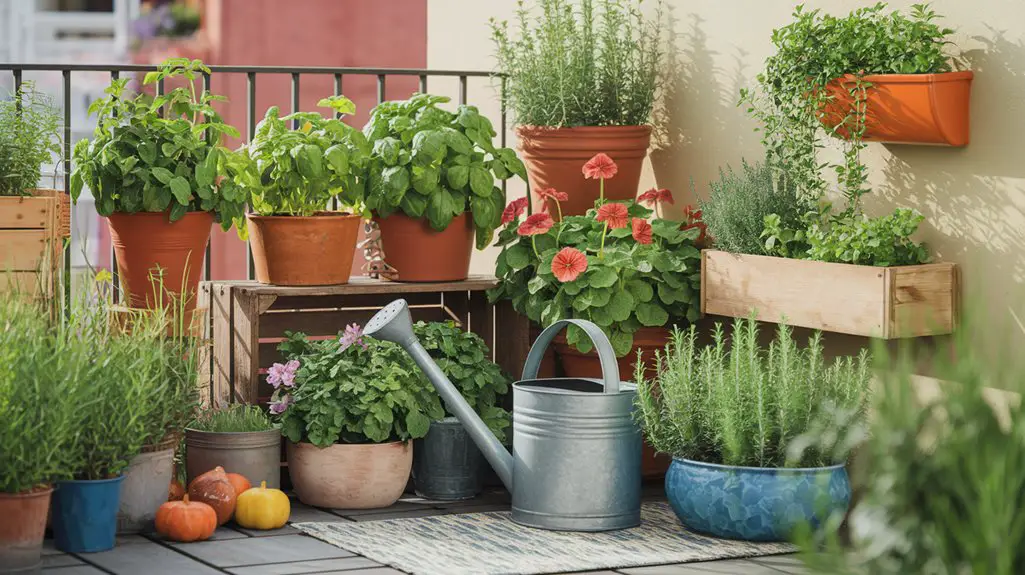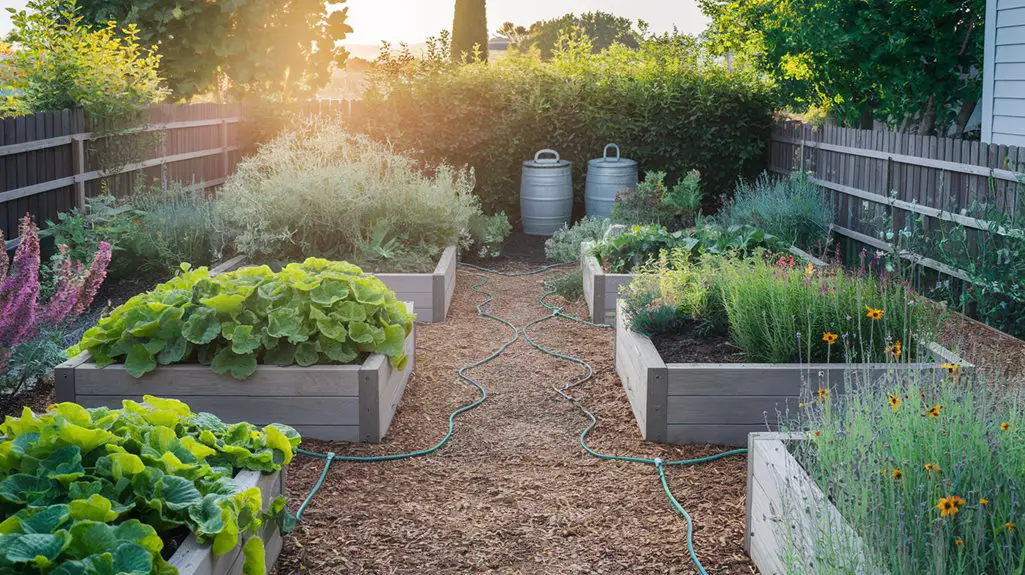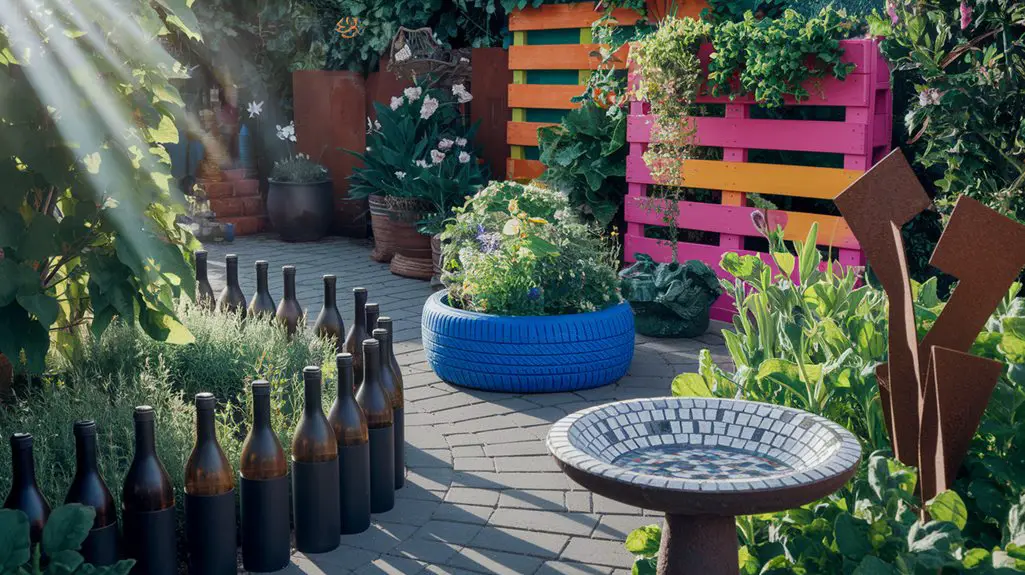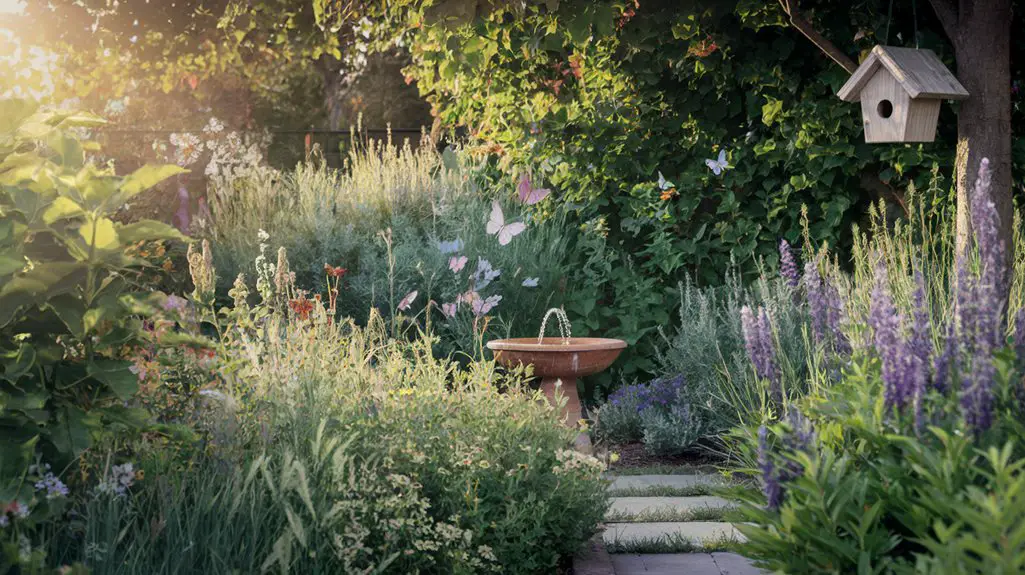Growing an Italian-style terrace garden in just three square feet of balcony space might seem impossible, but container herb gardens make it entirely achievable. You'll find that Mediterranean herbs like rosemary, basil, and thyme thrive in small spaces while providing fresh flavors for your kitchen. Whether you're working with a tiny apartment balcony or a compact patio, the right containers and planting strategies can transform your limited outdoor area into a productive herb haven—and the solutions are both practical and surprisingly stylish.
Essential Culinary Herbs for Small-Space Container Gardens
When planning a container herb garden, selecting the right culinary herbs will maximize your limited space while guaranteeing you have fresh flavors at your fingertips.
Prioritize versatile Mediterranean herbs like basil, rosemary, thyme, and oregano, which thrive in containers and require similar growing conditions. Mint deserves its own pot due to its aggressive spreading habit, while compact varieties of parsley and cilantro offer high yields in small spaces.
For year-round harvesting, include perennials such as chives and sage alongside annuals. Consider dwarf varieties specifically bred for containers—they'll provide full flavor while requiring less space.
Group herbs by water needs: drought-tolerant rosemary and thyme in one container, moisture-loving basil and parsley in another. Additionally, herbs can grow well in raised bed herb gardens, which optimize space and organization for your plants.
This strategic approach guarantees your small-space herb garden delivers maximum culinary impact.
Vertical Container Systems to Maximize Balcony Space

Vertical container systems represent the perfect solution for balcony gardeners who've mastered herb selection but face severe space constraints.
These ingenious setups utilize your balcony's vertical space, transforming bland walls into productive growing areas.
Consider installing tiered plant stands that cascade herbs at multiple levels, or mount pocket planters directly onto walls or railings.
Repurposed shoe organizers make excellent herb homes, with each pocket hosting a different culinary variety.
For a more polished look, invest in modular stacking planters that build upward instead of outward.
Don't overlook your balcony ceiling—hanging baskets can suspend trailing herbs like thyme and oregano overhead.
Trellises against walls support climbing varieties while creating visual interest.
With vertical systems, even the most limited balcony becomes a productive herb paradise. Additionally, creative herb garden ideas can inspire various planting arrangements that complement your vertical setup.
Repurposed and Upcycled Container Ideas for Herb Gardens

Creating an herb garden doesn't require purchasing expensive containers since everyday household items can be transformed into charming and functional planters. The sustainability of repurposing items not only saves money but adds unique character to your space. Incorporating eco-friendly practices can enhance your gardening experience while being kind to the environment.
| Repurposed Item | Ideal Herbs | Special Considerations |
|---|---|---|
| Old teacups/mugs | Thyme, Chives | Drill drainage holes; best for small herbs |
| Wooden crates | Rosemary, Sage | Line with landscape fabric; offers rustic appeal |
| Tin cans | Mint, Cilantro | Remove labels; paint exterior to prevent rust |
Look for items with good drainage potential or where you can easily add holes. Mason jars, old boots, wooden pallets, and even colanders make excellent upcycled planters. Remember to take into account each herb's specific needs regarding depth, drainage, and sunlight exposure.
Self-Watering Container Solutions for Busy Urban Gardeners

For busy urban gardeners with hectic schedules, self-watering containers offer a practical solution to maintain thriving herb gardens without daily maintenance.
These innovative systems use a reservoir that gradually delivers water to your herbs as needed, ensuring consistent moisture levels for ideal growth. Additionally, container vegetable gardening allows for versatile gardening options, perfect for small spaces.
You'll find several effective self-watering options on the market:
- Water-wicking systems that draw moisture upward through capillary action
- Two-chamber designs with a lower reservoir that feeds the upper growing medium
- Terra cotta spike attachments that slowly release water from repurposed bottles
Self-watering containers work particularly well for moisture-loving herbs like mint, basil, and parsley.
However, Mediterranean herbs such as rosemary and thyme prefer drier conditions, so adjust your watering system accordingly or choose traditional containers for these varieties.
Companion Planting Strategies for Balcony Herb Containers
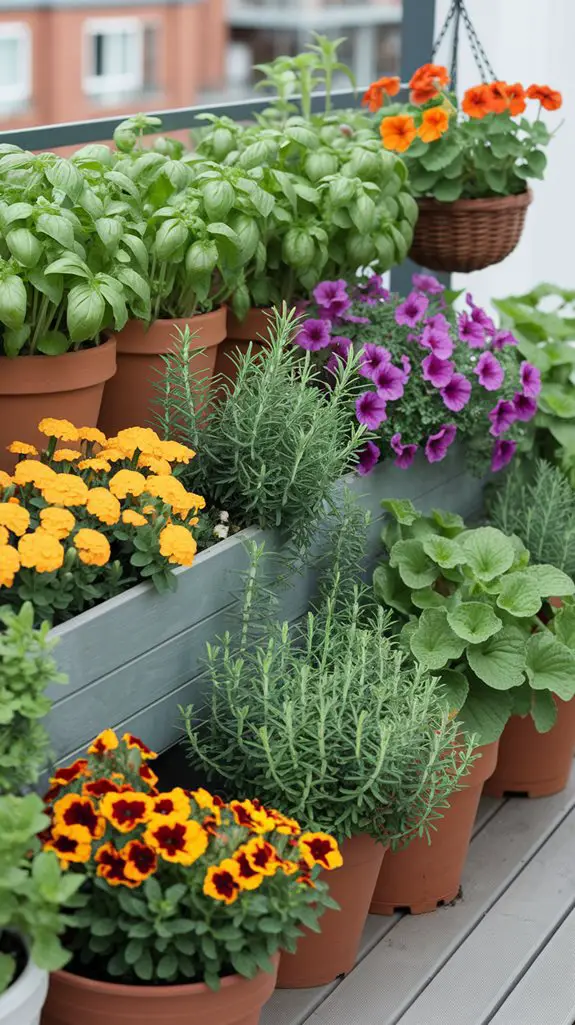
Companion planting in balcony herb containers maximizes both space and plant health by strategically grouping herbs that benefit each other.
Pair basil with tomatoes to improve flavor and repel flies and mosquitoes. Plant rosemary alongside sage, as both enjoy similar dry soil conditions and deter cabbage moths and carrot flies.
Consider the "three sisters" approach by combining tall herbs like dill with spreading varieties like thyme and deep-rooted plants like parsley.
You'll also want to avoid problematic combinations—keep mint in separate containers, as it's invasive and will overwhelm neighbors.
For successful balcony companion planting, group herbs with similar water requirements together.
Mediterranean herbs like oregano, thyme, and lavender thrive in the same dry conditions, while cilantro and chives prefer consistent moisture. Additionally, incorporating organic pest control methods can help maintain a healthy herb garden by naturally deterring unwanted insects.
Choosing the Right Soil and Fertilizer for Container Herbs
Unlike garden beds, container herbs require specialized soil that balances drainage with water retention.
Look for potting mixes specifically formulated for herbs or create your own by combining equal parts potting soil, compost, and perlite or vermiculite. This guarantees roots receive adequate oxygen while retaining essential moisture.
For fertilizing container herbs, follow these guidelines:
- Use organic, slow-release fertilizers at half the recommended strength to prevent leaf flavor degradation
- Apply liquid seaweed or fish emulsion monthly during growing season for micronutrient support
- Incorporate compost tea for beneficial microorganisms without chemical burn risk
Avoid standard garden soil in containers as it compacts easily, restricting root growth.
Most herbs prefer slightly acidic to neutral pH (6.0-7.0), with the exception of Mediterranean varieties that tolerate more alkaline conditions.
Seasonal Herb Rotation for Year-Round Harvests
While dedicated gardeners can maintain select herbs throughout the year, implementing a strategic seasonal shift maximizes your container garden's productivity and guarantees fresh harvests regardless of the calendar month.
Start spring with quick-growing cilantro, dill, and chervil, then shift to heat-loving basil, oregano, and rosemary for summer.
As temperatures cool, replace spent summer herbs with sage, thyme, and parsley, which thrive in autumn's milder conditions.
For winter, focus on cold-hardy options like rosemary and mint in protected areas, or bring containers indoors for windowsill varieties such as chives and microgreens.
Additionally, consider incorporating year-round herb garden inspiration to diversify your selections and enhance your culinary experience.
Keep detailed records of each herb's performance during different seasons, noting which varieties excel in your specific climate to refine your rotation schedule annually.
Decorative Container Arrangements That Enhance Balcony Aesthetics
Beyond their culinary value, herb containers can transform your balcony into a visually striking outdoor retreat.
Arrange containers at varying heights using plant stands, hanging baskets, and wall-mounted planters to create visual dimension. Mix herbs with complementary flowers like nasturtiums or pansies for pops of color that attract pollinators.
For maximum aesthetic impact, consider:
- Coordinated containers in terracotta, colorful ceramics, or metallic finishes that complement your balcony's existing design elements
- Vertical herb gardens using trellises or repurposed pallets that maximize limited space while creating a living wall effect
- Themed arrangements like Mediterranean herbs (rosemary, thyme, oregano) in blue pottery that evoke a coastal atmosphere
Choose containers with proper drainage and position them strategically to balance visual interest with practical harvesting access. Additionally, incorporating sustainable gardening practices in your container herb garden can enhance both plant health and environmental benefits.
Pest Management Tips for Healthy Balcony Herb Gardens
Maintaining a pest-free environment for your balcony herb garden requires vigilance and preventative measures that protect your plants without compromising their culinary quality.
Inspect your herbs weekly, checking leaf undersides for aphids, spider mites, and whiteflies. These common pests thrive in container settings.
Introduce natural predators like ladybugs or apply neem oil as an organic deterrent. Create physical barriers by placing sticky traps or reflective mulch around containers.
Avoid overwatering, which attracts fungus gnats and encourages root rot. Instead, water at the base during morning hours.
For severe infestations, try insecticidal soaps specifically formulated for edible plants. Additionally, consider using effective natural pest control strategies that can help safeguard your herbs from unwanted invaders.
Remember that proper spacing between containers improves air circulation, reducing mildew issues and making it harder for pests to migrate between plants.
Conclusion
With these container herb garden ideas, you'll transform your modest balcony into an aromatic oasis that's as practical as it is beautiful. Like a chef's palette of flavors at your fingertips, your vertical gardens, companion plantings, and self-watering systems will flourish year-round. Balance aesthetics with function, and you'll create not just a garden, but a living sanctuary that nourishes both your culinary creations and your spirit.

